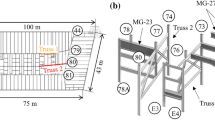Abstract
In October 2019, the largest fire in a commercial building in New Zealand since 1947 burned for over ten days through the roof and upper floor of the 120 m wide × 100 m long New Zealand International Convention Centre, which was under construction and nearing completion at the time. The steel composite and reinforced concrete framed building features five storeys above grade of structural steel framing with composite floors, comprising heavy, intricate steel work that was impacted by the fire. The main steel structure performed very well in response to fire exposure ranging from low to severe, with minimal damage and distortion to the heavy steel roof members in general, considering the severity of the fire. Secondary steel angles, tubular steel, and wide-flange members at the roof elevation were locally more heavily distorted. A very detailed post-fire evaluation of the structure was carried out, comprising mapping of the fire effects, deflections, metallurgical changes, extensive numerical modelling, and full scale in-situ experimental testing. The outcome resulted in retention of over 95% of the total roof steelwork (2500 tonnes). This paper provides an overview of the fire and the key steps involved in the post-fire structural evaluation of this unique fire case history.























































Similar content being viewed by others
References
Eurocode 3: Design of steel structures—Part 1–2: general rules—structural fire design. EN 1993–1–2; CEN, Brussels April 2005.
Kodur V, Dwaikat M, Fike R (2010) High-temperature properties of steel for fire resistance modeling of structures. J Mater Civil Eng 22(5):423–434
Bisby L (2018) Grenfell Tower Inquiry report. Phase 1: Expert report. https://www.grenfelltowerinquiry.org.uk/evidence/professor-luke-bisbys-expert-report
Storesund K, Sesseng C, Fjellgaard Mikalsen R, Holmvaag OA, Steen-Hansen A (2020) Evaluation of fire in Stavanger airport car park.
Peng L, Ni Z, Huang X (2013) Review on the fire safety of exterior wall claddings in high-rise buildings in China. Procedia Eng 62:663–670
Andrés R. Martínez, Jenny Gross (2023) London Airport Suspends Flights After Parking Garage Collapses From Fire. The New York Times. https://www.nytimes.com/2023/10/10/world/europe/luton-airport-fire-london.html
Hall S, Evarts B (2022) Fire Loss in the United States During 2021. National Fire Protection Association (NFPA).
Gil A, Kodur V, Pacheco F, Schneider D, Christ R, Tutikian B (2022) Post-fire assessment and retrofitting of concrete buildings: case study. ACI Struct J 119(5):57–67
Pandey M, Young B (2021) Post-fire mechanical response of high strength steels. Thin-Walled Struct 164:107606
Wang XQ, Tao Z, Hassan MK (2020) Post-fire behaviour of high-strength quenched and tempered steel under various heating conditions. J Constr Steel Res 164:105785
Li GQ, Lyu H, Zhang C (2017) Post-fire mechanical properties of high strength Q690 structural steel. J Constr Steel Res 132:108–116
Dan WJ, Gou RB, Yu M, Ge YB, Li TJ (2022) Experimental study on the post-fire mechanical behaviours of structural steels. J Constr Steel Res 199:107629
Alba-Rodríguez MD, Martínez-Rocamora A, González-Vallejo P, Ferreira-Sánchez A, Marrero M (2017) Building rehabilitation versus demolition and new construction: economic and environmental assessment. Environ Impact Assess Rev 66:115–126
Maraveas C, Fasoulakis Z, Tsavdaridis KD (2017) Post-fire assessment and reinstatement of steel structures. J Struct Fire Eng 8(2):181–201
Molkens T, Van Coile R, Gernay T (2017) Assessment of damage and residual load bearing capacity of a concrete slab after fire: applied reliability-based methodology. Eng Struct 150:969–985
Blanc CM, Sánchez AO, Navarro IF (2022) Evaluation of steel structures integrity in a post-fire condition: case study of the Serradells sports centre in Andorra. Fire Saf J 2022(133):103668
Wilding P (2020) Fire Investigation Report Incident No F2866954, Fire and Emergency New Zealand.
Franssen JM, Gernay T (2019) User Manual for SAFIR 2019. A Computer Program for Analysis of Structures at Elevated Temperature Conditions, University of Liege.
ABAQUS, Inc. (2020) ABAQUS/Standard, User’s Manual, Version 2020, Distributed by Dassault Systemes SIMULIA.
de Silva D, Bilotta A, Nigro E (2016) Experimental Tests on Intumescent Coating for Protecting Steel Structures, Proceedings of the Ninth Structures in Fire conference, Michigan, pp. 1081–1089.
Xu Q, Li G, Jiang J, Wang Y (2018) Experimental study of the influence of topcoat on insulation performance of intumescent coatings for steel structures. Fire Saf J 101:25–38
Krishnamoorthy RR, Bailey C (2009) Temperature Distribution of Intumescent Coated Steel Framed Connection at Elevated Temperature, Nordic Steel Construction Conference, Malmo.
NZS 3404 1997/2001/2007 Steel Structures Standard Incorporating Amendments 1 and 2, Standards New Zealand, Wellington, New Zealand.
Acknowledgements
We are grateful to SkyCity, the owner of the NZICC, for permission to publish this work. Acknowledgement and gratitude go to the contributors from Beca Engineering, Fletcher Construction Company, SkyCity, Holmes Fire, The University of Auckland, SGS, Simpson Gumpertz & Heger and Culham Engineering for the many hours of effort they applied over several years. Thanks go to Fanqin Meng who summarised past fire investigation work on similar case histories to illustrate how our investigation is consistent with the state-of-the-art.
Funding
This research was supported by The Fletcher Construction Company Ltd.
Author information
Authors and Affiliations
Corresponding author
Additional information
Publisher's Note
Springer Nature remains neutral with regard to jurisdictional claims in published maps and institutional affiliations.
Rights and permissions
Springer Nature or its licensor (e.g. a society or other partner) holds exclusive rights to this article under a publishing agreement with the author(s) or other rightsholder(s); author self-archiving of the accepted manuscript version of this article is solely governed by the terms of such publishing agreement and applicable law.
About this article
Cite this article
Clifton, G.C., Hogan, L., Stephens, M.T. et al. Post-Fire Evaluation of the New Zealand International Convention Centre. Fire Technol (2023). https://doi.org/10.1007/s10694-023-01516-2
Received:
Accepted:
Published:
DOI: https://doi.org/10.1007/s10694-023-01516-2



